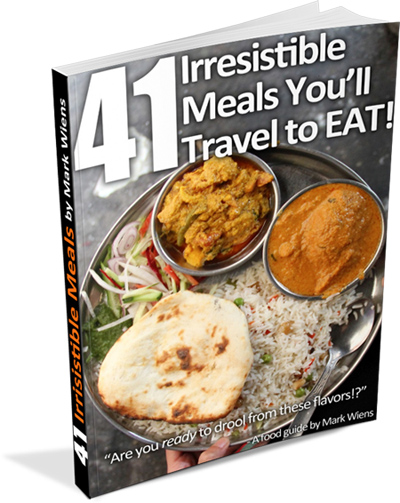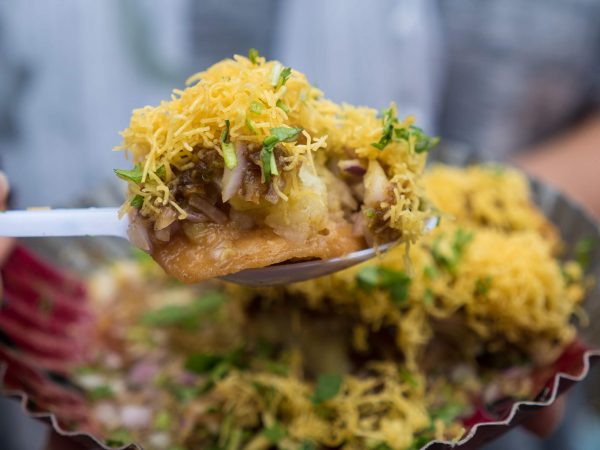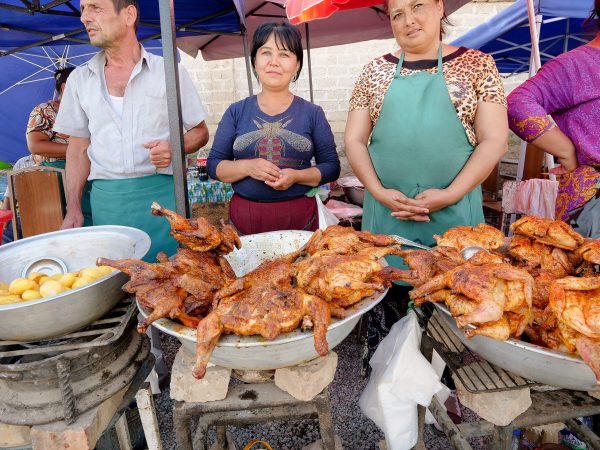
Delhi, India, is a giant city that contains an overwhelming amount of history, culture, life, food, temples, and everything else you could possibly imagine.
Throughout this guide of things to do in Delhi I’ve listed each attraction, given them all a brief introduction, and then shared my notes and personal visiting tips, which I think you’ll find useful.
I’m going to be honest, not everything is a breeze to accomplish in India, and that goes for the capital too.
Things don’t always turn out how you want them to, and there will always arise some frustrations when touring around.
But don’t let the annoyances get you down, keep a positive attitude. I would recommend not wearing anything too fancy or ritzy, and if you’re a female, I would encourage you to dress very modestly, and possibly even wear a head covering / scarf.
That being said, the culture, history and food in Delhi is incredible!
If you haven’t already seen it, be sure to check out my Delhi travel guide for many more tips and useful information.
Where to stay?
Here are a few of the hotels I recommend in Delhi:
- Oberoi New Delhi (High end) – One of the best high end hotels in Delhi is the Oberoi New Delhi.
- Saket Bed and Breakfast (Mid-range) – Saket is a wonderuful bed and breakfast that feels like you’re staying in a luxury home. It extremely well furnished, clean, safe, and in a nice neighborhood in South Delhi.
- Bloomrooms (Mid-range) – Also located in South Delhi, Bloomrooms is a flash-packer style mid-range place to stay.
- Smyle Inn (Budget) – Located in the Paharganj area of Delhi, this is a good budget accommodation option near the railroad station.
Read my full post about accommodation in Delhi.
Transportation
I took the Metro everywhere to get to all of these attractions. It’s clean, efficient, often packed, and extremely cheap. To make your life easier, it’s nice to buy a Metro card (50 Rupees deposit) and add some cash on it, rather than purchasing a new ticket every ride. Alternatively there’s also 1 day (100 Rupees) and 3 day (250 Rupees) Metro tourist passes available. After getting off the Metro you can either walk or take a short auto rickshaw ride to everything included on this list.
HOHO Bus (Hop On Hop Off) – Like quite a few other major cities, Delhi has a tourist designed bus where you can pay a set fee for a 1 or 2 day period and the bus goes from attraction to attraction. You can get off wherever you like and stay as long as you want, and the buses come something like every 30 – 45 minutes throughout the day. The HOHO bus doesn’t run on Monday.
One last word of advice: In Delhi I was shorthanded change after paying for a number of different attractions. I know officials occasionally do this on purpose, because at Qutub Minar I counted my change, was 100 Rupees short, so I turned back to the counter, and he immediately gave me 100 Rupees without saying anything… he knew all along, but was hoping I didn’t count. Count your change, and demand that you are given the correct amount!
Now let’s jump straight into these 25 things to do…
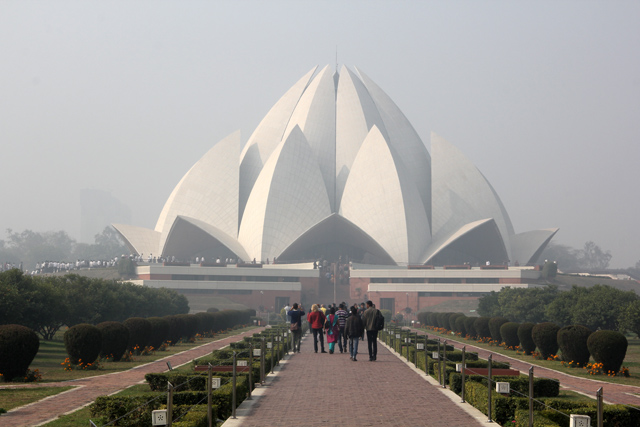
1.The Lotus Temple (Bahá’í House of Worship)
Among the numerous recognizable landmarks which are scattered all around Delhi is the remarkable Lotus Temple. Designed in the shape of a sacred lotus flower, there are 27 flower petals which are constructed of marble and make up the structure.
Though it’s dedicated to the Bahá’í faith, it’s a religious worshipping grounds for people of all religions (as such is the philosophy of the Bahá’í faith). As you approach the temple, you’ll walk through some nicely manicured gardens and then have an opportunity to place your shoes in the free and secure shoe deposit room. You’ll then be given a 2 minute briefing by a volunteer, mainly about turning off your cell phone and keeping silent, and then you’ll be free to enter the sanctuary and sit in pure silence for as long as you’d like.
How to get there: I took the Metro to Kalkaji Mandir station and from there it’s about a 10 minute walk to the entrance gate – you’ll see the giant lotus from the Metro as you approach.
Website: http://www.bahaihouseofworship.in/
Hours: Tuesday – Sunday from 9 am – 7 pm, closed on Mondays
Price: Free
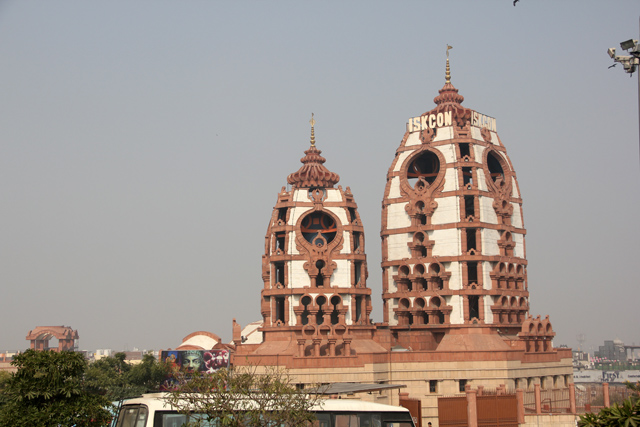
2. ISKCON Hare Krishna Temple
Located just a 15 minute walk from the Lotus Temple (though you have to walk around due to the fence), is one of the largest and most interesting temples dedicated to the International Society for Krishna Consciousness.
The religious movement was actually founded in the United States and is now represented throughout India. Visiting the temple, you’ll be able to freely walk around and sit in the sanctuary where you can listen to the ever present drum and chant of “Har-e-Krishna.” I think they also have a theater where you can watch a film, but I didn’t see it.
How to get there: The closest Metro station is Nehru Place and the temple is about a 10 minute walk from the station. As mentioned above, I visited after going to the Lotus Temple.
Website: http://www.iskcondelhi.com/
Address: Hare Krishna Hill Sant Nagar, East of Kailash New Delhi, India
Hours: Day hours
Price: Free
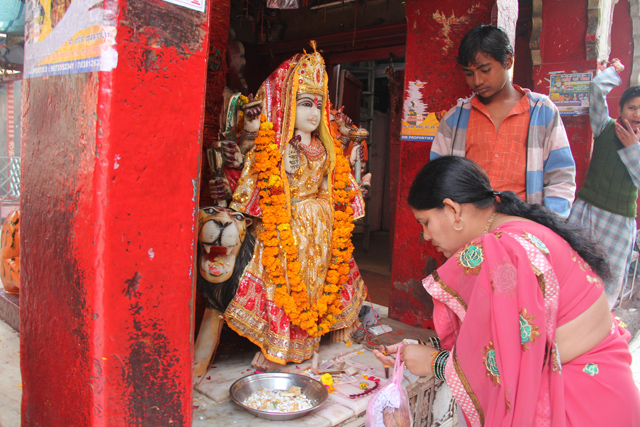
3. Kalkaji Mandir Hindu Temple
The final temple making a trio of temples surrounding the Lotus Temple, is the Hindu Kalkaji Mandir. It’s not a big tourist attraction, and mostly (at least when I was there) it’s a temple where locals go. The temple is dedicated to the Goddess Kali and is the site of many rituals that include singing and chanting.
When I was there, it looked like a number of babies were being dedicated. Not wanting to leave my shoes somewhere unattended, I stuck them in a plastic bag and carried them around with me, and nobody bothered me like at some other temples such as the Kalighat temple in Kolkata.
How to get there: Take the Metro to Kalkaji Mandir station and it’s just a 5 minute walk from there, it’s right across the street from the entrance gate to the Lotus Temple.
Hours: Tuesday – Sunday from morning until night, closed on Mondays
Price: Free
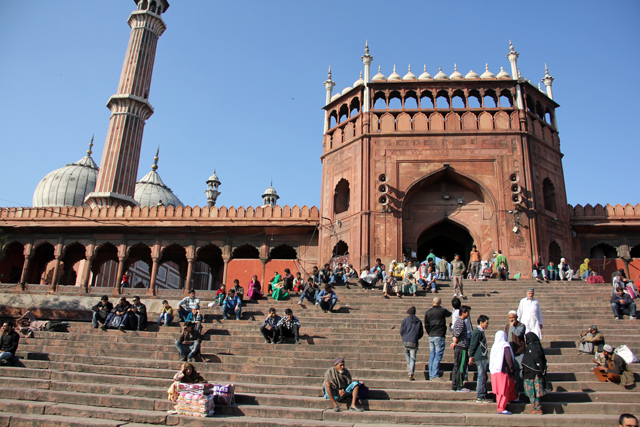
4. Jama Masjid
It was the during the Islamic Mughal empire when many of Delhi’s famous ancient sites were constructed. In the heart of Old Delhi, located right at Chawri Bazar and very close to Chandni Chowk is the largest Islamic mosque in the city, Jama Masjid. It’s a huge structure, built in the 17th century, and includes multiple entrances that all lead to the main worship deck. The mosque has two towering minarets and a few onion shaped domes. The giant expanse on the upper floor has a capacity to hold 25,000 people. There are some great restaurants like Karim’s and others within the vicinity.
Note: When you approach any entrance of the mosque someone will stop you and ask you to pay 300 Rupees (a bit overly steep in my opinion). So I stopped and read all the official rules posted on the wall. It clearly states, that only “Cameras including mobile phone cameras will be charged 300 Rupees.” So I decided to not take any photos inside (just took photos from the outside), and they still wanted to charge me, but I simply just went in without paying. Of course, once inside, many local Indians were taking photos with their phones, and it’s pretty safe to say, they didn’t pay 300 Rupees. If you want to take photos inside the mosque, the rule states to pay 300 Rupees, but if you just want to enter without taking photos, DON’T let them charge you!
How to get there: I took the Metro to Chawri Chowk station, exited at Gate #3, and from there you just walk straight down the street for about 10 – 15 minutes and the road will lead you right to the mosque. You can then either take a left or right to get in either main gate of the mosque.
Hours: 8 am – 30 minutes before sunset
Price: Free to enter, 300 INR to take photos
Get exclusive updates
Enter your email and I’ll send you the best travel food content.
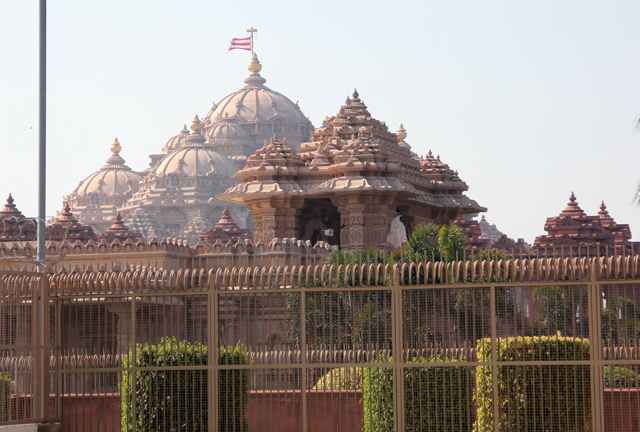
5. Akshardham Temple
This modern Hindu temple complex, which was built in 2005, is one of the things to do in Delhi that you don’t want to leave out seeing. Akshardham, with its elaborate architecture, construction, and its ridiculous amount of perfect detail and decoration will blow your mind.
They don’t allow anything inside the temple complex, but they do have a very secure (and free) place to store all your belongings – you’ll have to deposit your camera, phone, and everything, but they’re safe and their system is very organized. You then walk into the gates, proceed through the visitor center, and you’ll be standing directly in front of the stunning temple. Keep approaching, deposit your shoes, and enter the temple.
The interior of the temple is unbelievable; What you’ll see will make your jaw drop. The amount of labor and craftsmanship that went into building Akshardham is unimaginable. Sorry, they don’t allow any photos, so you’ll have to see it for yourself!
How to get there: Take the Delhi Metro to Akshardham station (make sure you head towards NOIDA city center station), exit to the main street, turn right and then turn right again on the road and walk for about 10 minutes and you’ll be at the main entrance gate. Alternatively, you can take a rickshaw from the Metro to the temple.
Website: http://www.akshardham.com/
Hours: 9:30 am – 6:30 pm, closed on Monday
Price: Free

6. Gurudwara Bangla Sahib (Sikh Temple)
Unlike the uneasy feeling of visiting Jama Masjid (where someone always seems to be asking for money and your shoes are likely to get stolen if you leave them somewhere), the Gurudwara Bangla Sahib Sikh Temple is about the friendliest, most inviting, and comfortable temple you’ll ever visit. Nobody will ask you for money, a donation, or anything. You just leave you shoes safely in the deposit room and walk around the temple.
There’s a huge pool of water outdoors on one side, a dining facility where many people share a meal together each day, and even a medical facility. Go inside the temple and you can sit and enjoy the Sikh band playing drums and singing as you sit there in peace. It’s a really great experience, and I’d label it as a must visit when you’re in Delhi.
How to get there: Take the Metro to Patel Chowk, from there walk along Ashok Road until you reach the back side of the temple. I think the walk took me about 10 – 15 minutes.
Hours: Daytime hours
Price: Free
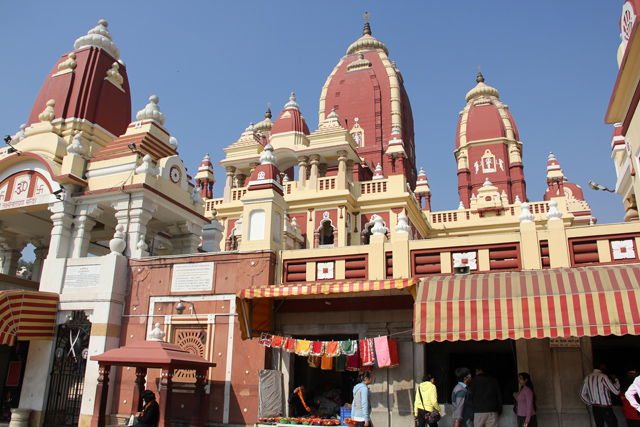
7. Laxmi Narayan Mandir – Hindu Temple
Also known as Birla Mandir, this significant Hindu temple complex in Delhi is now a main tourist attractions. The temple is famous as it was officially opened by Mahatma Gandhi and it’s a Hindu temple that is meant for people coming from all different castes of India. The temple was indeed nice, but I didn’t think it was near as impressive as Akshardham or even as interesting as Kalkaji Mandir.
Unlike some other temples in Delhi where they offer you secure and free place to leave your shoes without any pressures, at Laxmi Narayan Mandir they instruct foreigners to go in a special little room to leave your shoes and then you feel a bit obligated to leave a tip… though of course, as they say… “it’s up to you.”
How to get there: I took an auto rickshaw from the Sikh Temple for 40 INR, and I’d imagine you could get an auto rickshaw from Connaught Place for around 50 – 60 INR.
Hours: 6 am – 10 pm daily
Price: Free, but tip for shoes
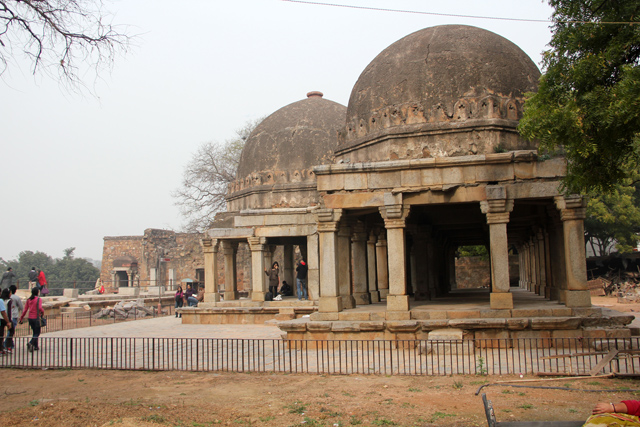
8. Hauz Khas Complex
The historical complex of Hauz Khas (originally known as Hauz-e-Alai) is an ancient community of ruins which includes a mosque, various tombs, and the previously important water tank.
Built in the early 1300’s, the water tank was designed to store rainwater to be used when needed in the dry season. Nowadays, the complex is a public Delhi park, a place where lots of students go to just hang out with friends, and chat while sitting on ancients stones and tombs. Delhi just has so many ancient Mughal buildings of history that there are many that are just public and not fully preserved, but are just part of the daily lives of residents – such is the case when it comes to Hauz Khas.
Hauz Khas Village, located surrounding the entrance of the ruins, is an upscale outdoor shopping area filled with boutique stores, high end restaurants, and cafes. When I was in Delhi, I stayed at a place near Hauz Khas. If you’re looking for where to stay in Delhi, South Delhi is a good area.
How to get there: The easiest way to get to Hauz Khas Complex and Village is by taking the Delhi Metro to Green Park station and then hopping in an auto rickshaw to Hauz Khas. It should cost 20 – 30 INR.
Website: http://hauzkhasvillage.in/
Hours: Daylight hours
Price: Free
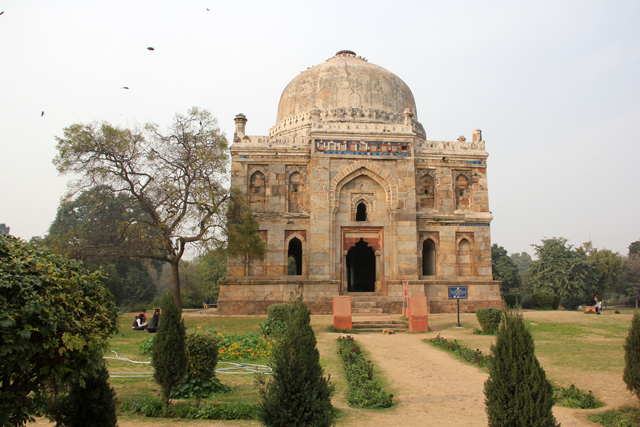
9. Lodi Gardens
Along with Qutub Minar and Akshardham, the Lodi Gardens was one of my favorite things to do in Delhi. It’s similar to Hauz Khas Complex, but on a much grander and more impressive scale.
The Lodi Gardens is a public park that’s scattered with ancient Mughal tombs and structures. Kids run around, people enjoy picnics, and artists become inspired by walking and sitting in these gardens. The park is large, and it’s easy to walk around for a few hours indulging in a breath of fresh air and exploring the 500 year old tombs.
I found it very interesting and hard to believe that such ancient and important buildings are just a normal part of everyday life in Delhi, really cool!
How to get there: I took the Metro to Khan Market station and from there it was about a 30 minute walk to Lodi Gardens. If you don’t want to walk, take the metro to Khan Market station and then jump in an auto rickshaw.
Hours: Daylight hours
Price: Free
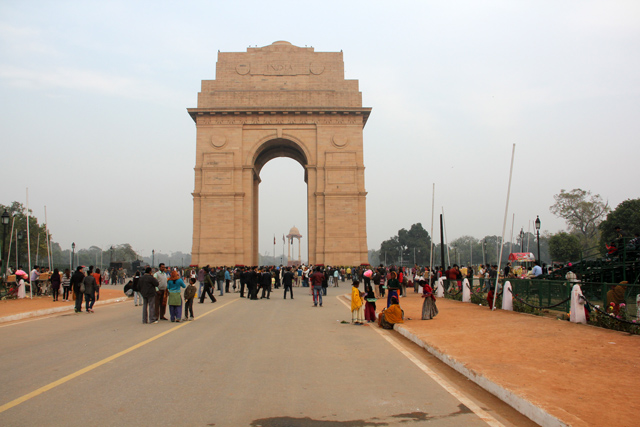
10. India Gate
The well respected India Gate is a 42 meter tall monument that was built in 1931 to honor Indian soldiers as a war memorial. Under the gate you can see a flame that’s continually lit and honors soldiers that have given their lives for their country.
Since the India Gate attracts quite a number of tourists, both locals and foreigners, there are also quite a few beggars and overly pushy sellers that hang around.
How to get there: The nearest Metro station is Central Secretariat, but it’s a bit of trek from there, I think it took about 30 minutes walking, but it’s not a bad walk and right along Rajpath. You can alternatively take an auto rickshaw or take a shared little motorcycle rickshaw up to the entrance of the India Gate.
Hours: Daylight hours
Price: Free
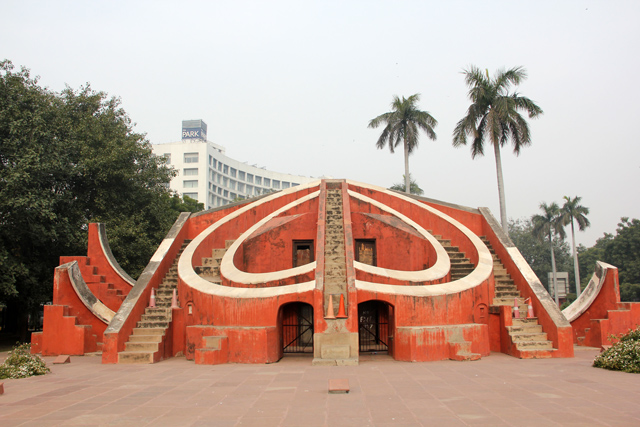
11. Jantar Mantar
The Jantar Mantar in New Delhi is a complex that includes a number of different structures used for astronomy observations. Commissioned by Muhammad Shah, the Mughal emperor, the structures were actually constructed by Maharaja Jai Singh II from Jaipur, Rajasthan (if you visit Jaipur, they have an even nicer Jantar Mantar).
The thirteen different instruments are all used for different purposes in figuring out sun, moon, and planet cycles, and other astronomy measurements.
How to get there: Jantar Mantar is located just a short distance from Connaught Place and you can take the Metro to either Rajiv Chowk or Patel Chowk and the attraction is located right along Sansad Marg. I took the Metro to Patel Chowk and it took about 10 minutes to walk there.
Address: Sansad Marg,Connaught Place, New Delhi, DL,110001, India
Website: http://www.jantarmantar.org/
Hours: Daylight hours
Price: 100 INR
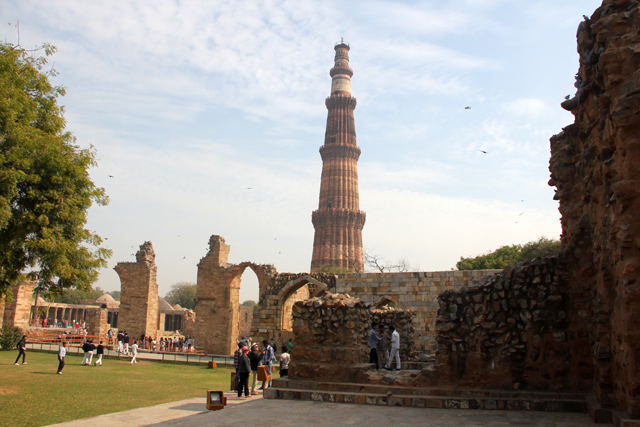
12. Qutub Minar
Among all the historical things to do in Delhi, the Qutub Minar is what I enjoyed most. Along with a bunch of crumblings structures is the incredible 72.5 meter minaret that sort of looks like the Leaning Tower of Pisa. The minaret is the tallest in all of India, and it was originally built nearly 1,000 years ago.
Constructed from red sandstone, there are detailed carvings and inscriptions throughout the tower. Though you can’t go inside, it’s really awe-inspiring to see from a distance and up close. Qutub Minar is now a UNESCO World Heritage Site and a proud icon of Delhi, India.
How to get there: Though there’s a Metro station named Qutub Minar, the actual site is sort of inconveniently located a bit of a distance away. It’s easiest to take the Metro and then take and auto rickshaw for 30 – 40 INR to the entrance.
Address: Mehrauli, New Delhi, Delhi 110030, India
Hours: 10 am – 6 pm daily
Price: 250 Rupees, but make sure you count your change, I was shorthanded!
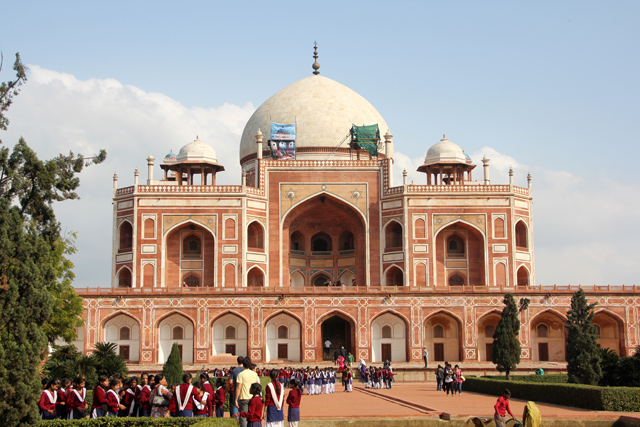
13. Humayun’s Tomb
Persian designed, the tomb was built in the mid 1500’s to house the Islamic Mughal emperor known as Humayun. Along with Humayun, there are quite a few other Mughal rulers whose graves are also within the building.
You can walk around the surrounding gardens and then proceed to climb a flight of stairs to the main deck. Then you can walk around the inside of the building and see the many marble tombstones. Also, located at the entrance of the attraction is a small museum showcasing some old photographs including explanations of the tomb and its history.
How to get there: There’s no real Metro station that will take you very close to Humayun’s Tomb, the closest is either Khan Market or JLN Stadium, but you still need to take an auto rickshaw from there. If you go to the Lodi Gardens, just take an auto rickshaw directly from there to the tomb.
Address: Mathura Road, Nizamuddin, New Delhi, DL 110013, India
Hours: 6 am – 6 pm daily, all daylight hours
Price: 250 INR – expensive because it’s another UNESCO World Heritage Site
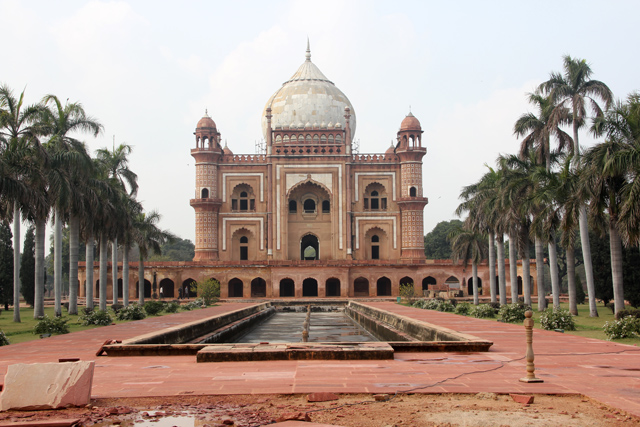
14. Tomb of Safdarjung
Originally constructed in 1754, the tomb was built for Safdarjung, a prominent leader under Muhammad Shah, the more powerful Mughal emperor. The tomb’s construction is very similar to Hamayun’s tomb, and it’s surrounded by Mughal gardens.
When I visited, I was the only tourist around, so it was quiet, I could hear the crows squawking, and it was a nice break to be away from the normal Delhi crowds. It’s not extremely well maintained, but they did appear to be doing a bit of maintenance when I went.
How to get there: Take the Metro to Safdarjung station, exit at Gate 2, make an immediate u-turn, and walk for a few hundred meters and you’ll see the entrance.
Hours: Daylight hours
Price: 100 INR
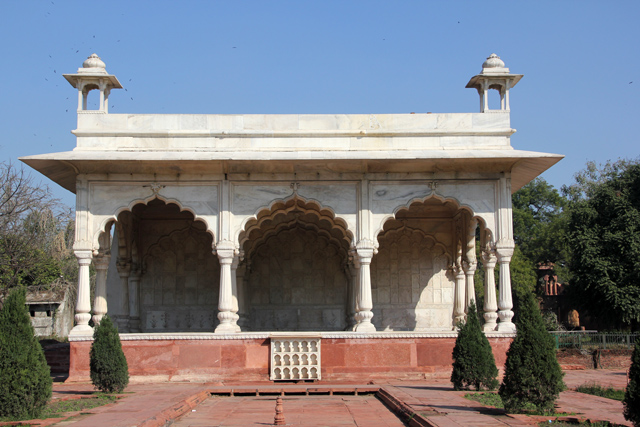
15. Red Fort
The Red Fort in Delhi, known as Lal Qila, is a red sandstone Mughal fortress of walls that surrounds an entire ancient city. Once you get inside the gate, you’ll be able to freely walk around and view some of the main structures, halls, and mosques. Along with being a place to learn and see the history of Delhi, it’s also just a quiet place to get away from the crowds and noise outside the walls. However, if you visit Agra, please go to the Agra Fort, I thought it was more impressive than the Red Fort in Delhi.
How to get there: You can easily walk in about 20 minutes or take a quick auto rickshaw ride from Chandni Chowk metro station to the Lahore Gate of the Red Fort. Just get off the Metro and walk straight down Chandni Chowk road until you reach the large main road, and you’ll see the fort across the street.
Address: Netaji Subhash Rd, Chandni Chowk, New Delhi, Delhi 110006, India
Hours: Tuesday – Sunday during daylight hours, closed Mondays
Price: 250 INR
16. National Museum of New Delhi
This, I’ll tell you straight up, is the only attraction on this list that I personally didn’t visit. But then again, the entire city of Delhi is like a hands-on entertaining museum, but if you’re really interested in art and history, you should definitely visit the National Museum. You’ll find an impressive quantity of over 200,000 individual pieces of art!
How to get there: Take the Metro to Central Secretariat, get out and head to Rajpath, walk towards the India Gate until you get to Janpath and that’s where the National Museum is located, about a 15 minute walk from the station.
Address: Janpath Road,Rajghat, New Delhi 110002, India
Website: http://www.nationalmuseumindia.gov.in/
Hours: 10 am – 5 pm on Tuesday – Sunday, closed on Monday
Price: 300 INR (which includes audio tour)
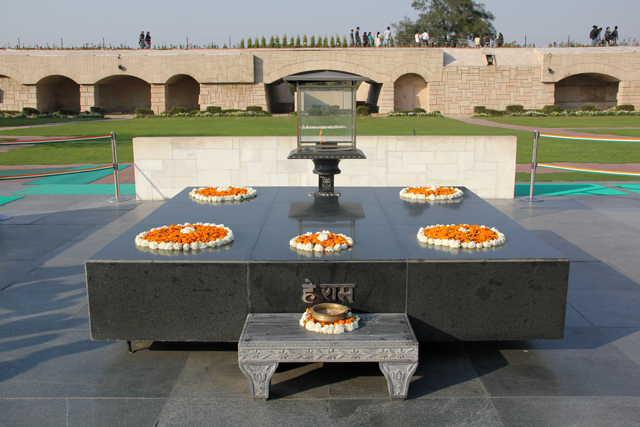
17. Raj Ghat – Gandhi Memorial
Mahatma Gandhi is likely the most famous person associated with India, he’s on the front of all Rupee notes; He was the founding father of modern independent India and he’s known throughout the world for his philosophy of nonviolence and his attitude of helping and caring for others. Raj Ghat is a memorial dedicated to Gandhi, and it’s located in the place where he was cremated.
The entire area is a park, and there happened to be a lot of students running around the day I went. When you enter the memorial, you leave your shoes at the counter (for a small tip), and then walk into the central courtyard where you can walk around the black marble memorial of Gandhi.
How to get there: To get there I took an auto rickshaw from Chandni Chowk to Raj Ghat for 60 INR and leaving I took an auto rickshaw to the nearest Metro station (Indraprasta) for 40 INR.
Hours: 5:30 am – 7 pm daily
Price: Free, but I paid a 20 Rupee tip to the shoe man
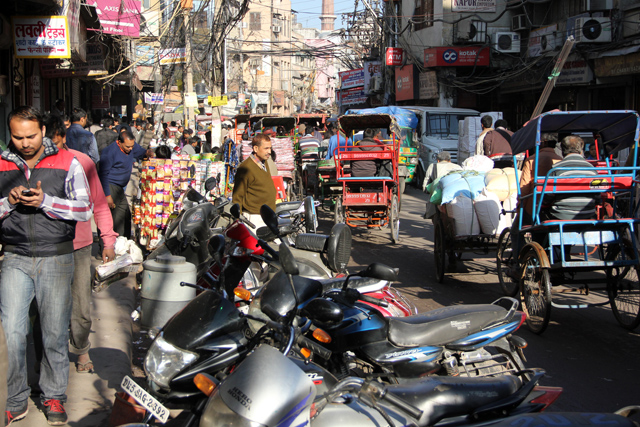
18. Chandni Chowk & Chawri Bazar
Due to my passion for street food, I was like a kid in a candy store when walking around Chandni Chowk and Chowri Bazar in Old Delhi. This area is a dense chaotic center of trade, business, food, spices, and overall life. You’ll find some of the most interesting people and businesses in all of Delhi in this compact district. You can walk through the narrow ancient lanes, stop in at the inviting Sikh temple, and visit both the Jama Masjid and Red Fort which are both in the area. There are also a number of hotels and places to stay located in Chandni Chowk.
Don’t miss the Paranthe Wali Gali or a chaat from Natraj!
How to get there: Take the Metro to either Chawri Bazar or Chandni Chowk station and you’ll be in the midst of action.
Hours: Day and night, I’d recommend going late morning until afternoon
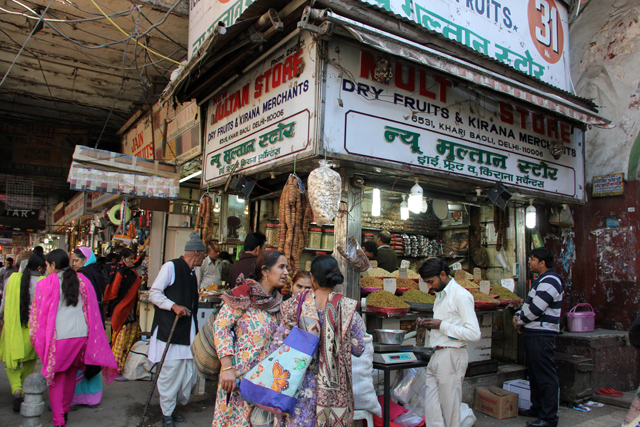
19. Spice Market (Khari Baoli in Old Delhi)
To the west side of Chandni Chowk, starting along Church Road, but really along Khari Baoli, you’ll find the Old Delhi spice market. It’s apparently the largest spice market in Asia, and you’ll be immersed in a colorful array of all things spices, dried fruits, nuts, and an army of rickshaw transporters and men just lying around on top of gunny sacks taking naps.
How to get there: Take the Delhi Metro to Chandni Chowk station, walk west along Chandni Chowk road until reaching the T-intersection. Make a right on Mission Church Road and turn left on Khari Baoli.
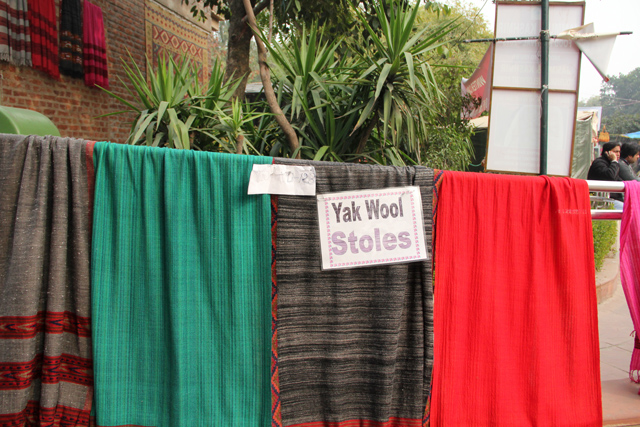
20. Dilli Haat – Handicraft Village
Dilli Haat is the exact opposite shopping experience from Chandni Chowk and the Spice Market; It’s calm, clean, organized, convenient, and really nicely set up. It’s a bit like Asiatique in Bangkok, but less glamourous. Dilli Haat is kind of an outdoor shopping plaza where vendors sell high quality Indian handicrafts in a friendly, safe environment.
Along with being a great place to shop for souvenirs and handicrafts, Dilli Haat is known (even for local Indians), as a nice place to sample Indian food from around the entire nation. I think there’s a restaurant representing each of the states of India. While I wanted to eat at every stall, I chose a North Indian restaurant called Mahak and enjoyed a vegetarian thali. I then ate a Rajasthani kulfi ice cream for dessert.
How to get there: Take the Metro to INA station and Dilli Haat is just a short walk from there
Address: Sri Aurobindo Marg, West Kidwai Nagar, Kidwai Nagar, New Delhi, DL 110023, India
Website: http://www.dillihaat.net.in/
Hours: 10:30 am – 10 pm daily
Price: They charge 20 Rupees entrance fee
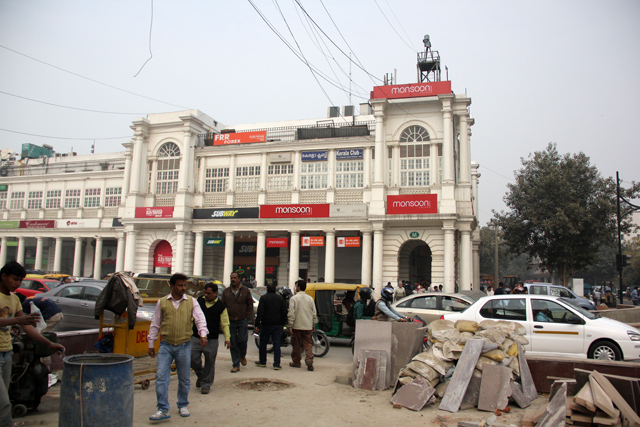
21. Connaught Place – Rajiv Chowk (& Palika Bazar)
While Delhi doesn’t exactly have a single downtown business district, if you did choose one area to label as that, it would probably be Connaught Place. Within the series of roundabouts which makes up the central framework of “CP,” are countless stores, delicious restaurants, and a dark underground shopping plaza known as Palika Bazar.
This mega series of roundabouts is honestly super confusing and a little overwhelming to the first time visitor. When I got off the Metro for the first time at Rajiv Chowk I had no clue what I was doing or where I was going, so I just wandered around a bit aimlessly. The next time I went, I brought my map (I’d recommend it), and had a few places (mostly restaurants), that I wanted to visit and marked them clearly on my map. A smartphone would be nice too if you use one.
How to get there: Take the Delhi Metro to Rajiv Chowk station and take any number of exits
Hours: Shops and restaurants start to open at about 10 or 11 am daily
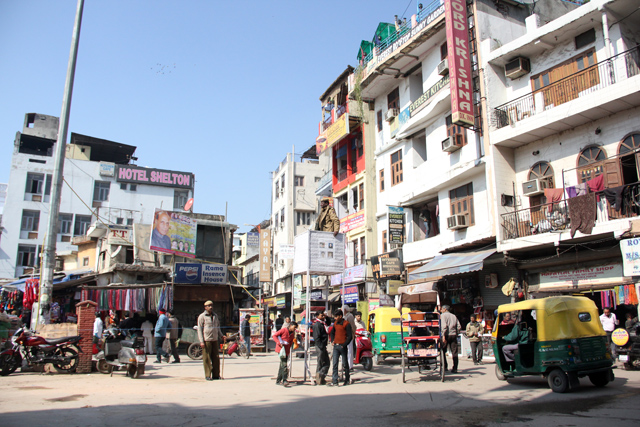
22. Paharganj (Main Bazar)
Located next to the New Delhi Railroad Station, Paharganj is a district in Delhi that is known for its crowded streets, shopping, and now its the budget backpacker center of Delhi. If you’re looking for where to stay in Delhi where you’ll have easy access to transportation and lots of action, head to Paharganj.
The area is yet another interesting area of Delhi to explore and includes a host of businesses and restaurants. I had the best chole bhature (fried bread served with a luscious chickpea curry) of my entire time in Delhi at a small restaurant known as Sita Ram Diwan Chand.
How to get there: You could take the Metro to Ramakrishna Ashram Marg and then walk to Paharganj, but I just took the Metro to New Delhi Station, walked through the Railroad Station to the other side (which is the Paharganj side), then crossed the street, and you’ll be in Paharganj. The road is called Main Bazar or Baba Namdev Marg.
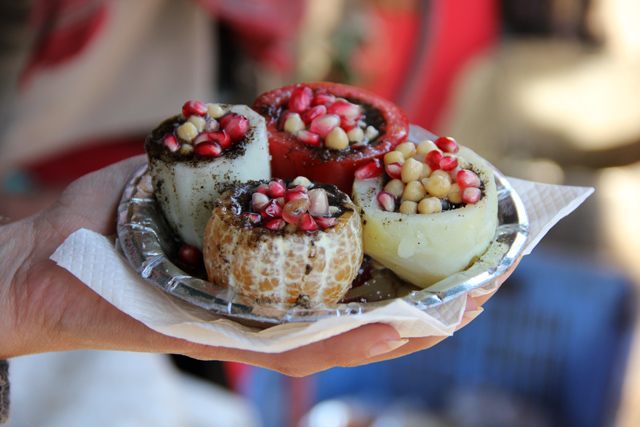
23. Kulle Chaat
From the moment I stepped off the airplane in Kolkata, I began to devour some remarkably tasty Indian food; Afterall, I traveled to India with a main intent to eat. But it was in Delhi, when I had my first sample of something known as Kulle Chaat, and my emotions hit peak high of pleasure.
This snack of various vegetables and fruits hollowed out and filled with a blend spices, lime juice, salt, chickpeas and pomegranate seeds was so simple and so life-changingly delicious, that I felt compelled to include it right here on this list of top 25 things to do in Delhi. That’s right, it was THAT good!
Note: Now here’s the problem, I ate it all (and licked the plate), and my stomach was fine. But, it could by all means contain droplets of unclean water or things like that, so if your stomach is not overly strong, be careful… but I personally would risk just about anything for another bite of Kulliya chaat.
How to get there: Take the Metro to Chawri Chowk, get out at Gate 3, walk straight down the hectic road on your left side and you’ll come to a highly attractive pan sizzling full of fried potato cutlets and bhaji. You’ll then see a small photo of kulle chaat on the wall and you’ll have to ask him for it. He’ll nod, and in just a moment, it will yours for the eating! The stall is called Hira Lal Chaat, but it’s only written in Hindi.
Hours: Lunch and evening, by street food operates on its own schedule
Price: 50 INR

24. Delhi Street Food
By now you probably know that I’m a street food and and all forms of food addict. So of course, in my opinion, sampling the marvelous array of Indian street food is one of the best things to do in Delhi, at least I think so.
For a quick street meal you’ll find chole, a spicy chickpea curry served from a golden upright gauntlet, served with either freshly cooked chapatis or a white bread that looks kind of like pita. It’s available on just about every corner of Delhi – and it’s really really good. Samosas, pakoras, and a variety of chaats (savoury snacks) are also very common throughout Delhi. To get the most diverse selection all in one place, you’ve got to spend some time wandering around Chandni Chowk where you’ll find a tantalizing quantity of interesting street food delights.
Prices: Delhi street food is a little more expensive than Kolkata street food, and you’ll pay 30 – 50 Rupees for a snack and 40 – 60 Rupees for meal.
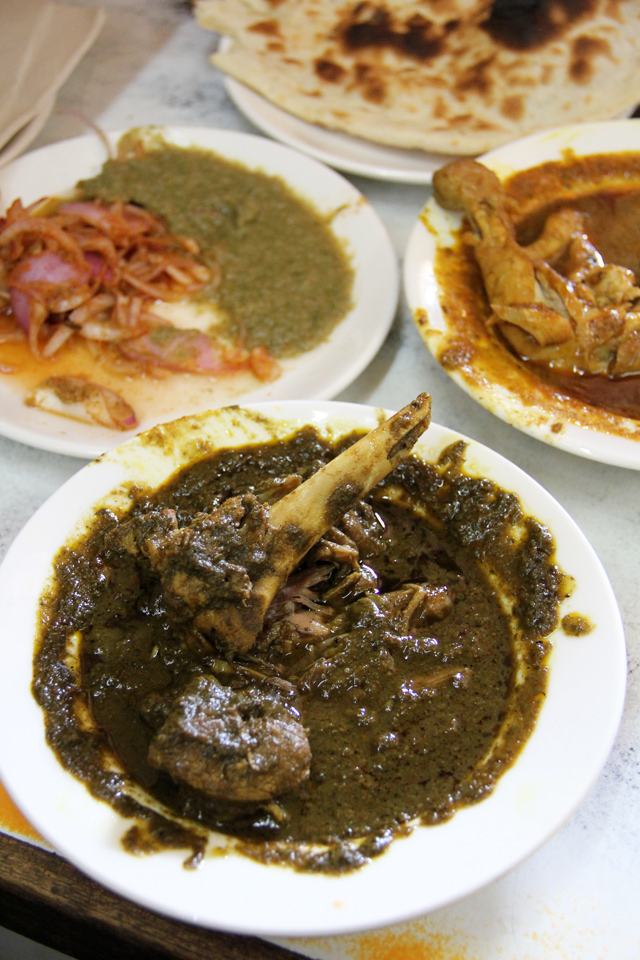
25. North Indian Food
While Delhi is a melting pot of cultures throughout India, and also people from around the world, eating home-grown cuisine is what I often strive to do. North Indian food is very rich, and it’s extremely flavorful and very satisfying. Breads like tandoori roti, chapatis, naan, and other fried breads are more common than rice, which is the staple of south Indian food.
Along with rotis you’ll discover incredible tandoori cooked chicken, paneer cheese cooked in a variety of different curries, and all sorts of different legumes like lentils, beans, and peas. You can find plenty of both pure vegetarian and non-vegetarian (meat) restaurants. Karim’s in Old Delhi and Bhape Da Hotel at Connaught Place were two awesome restaurants I ate at!
Here’s a video that includes 21 of these things to do in Delhi:
Thank you for following this mega-list of things to do in Delhi. I hope the information will help you to make the most of your time in Delhi, India!
P.S. Make sure you take a look at my Delhi travel guide now!
Get exclusive updates
Enter your email and I'll send you the best travel food content.
